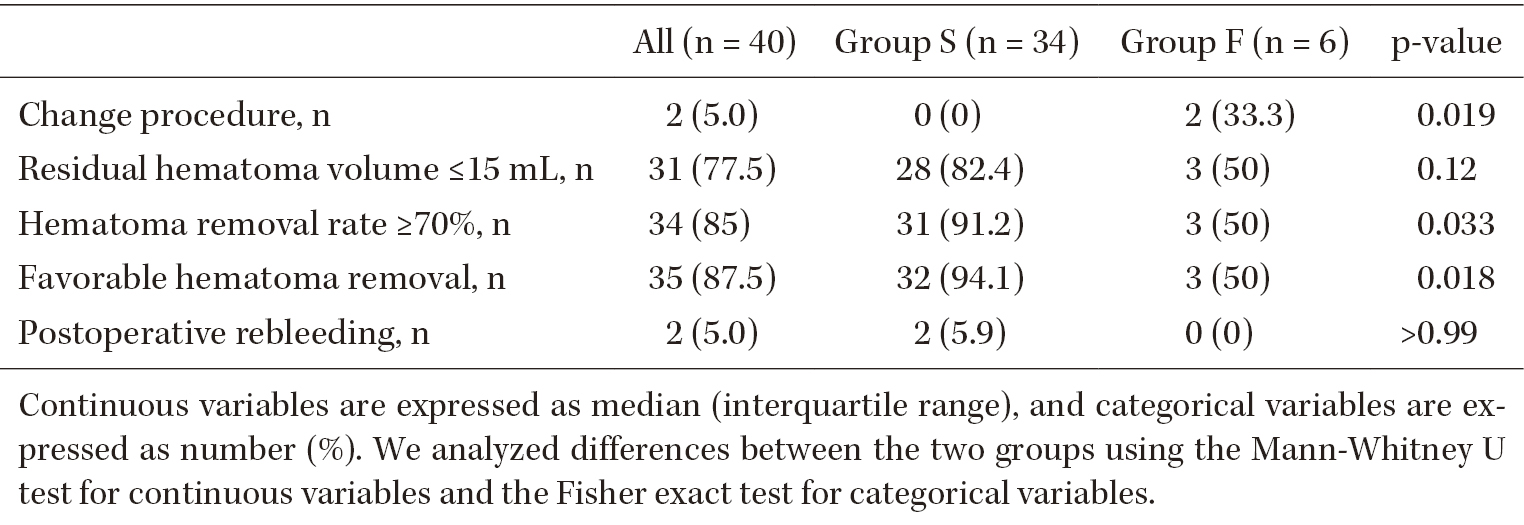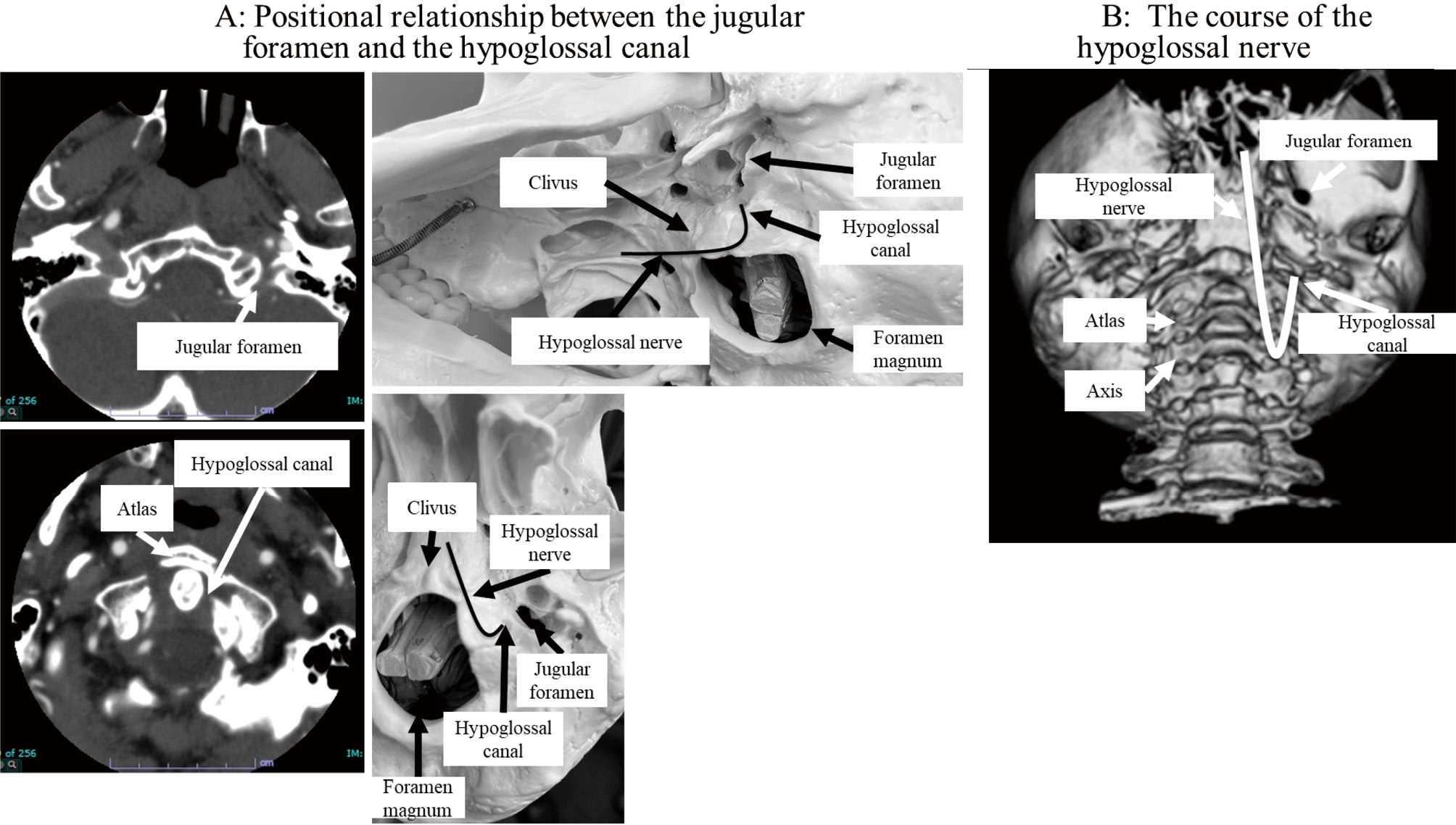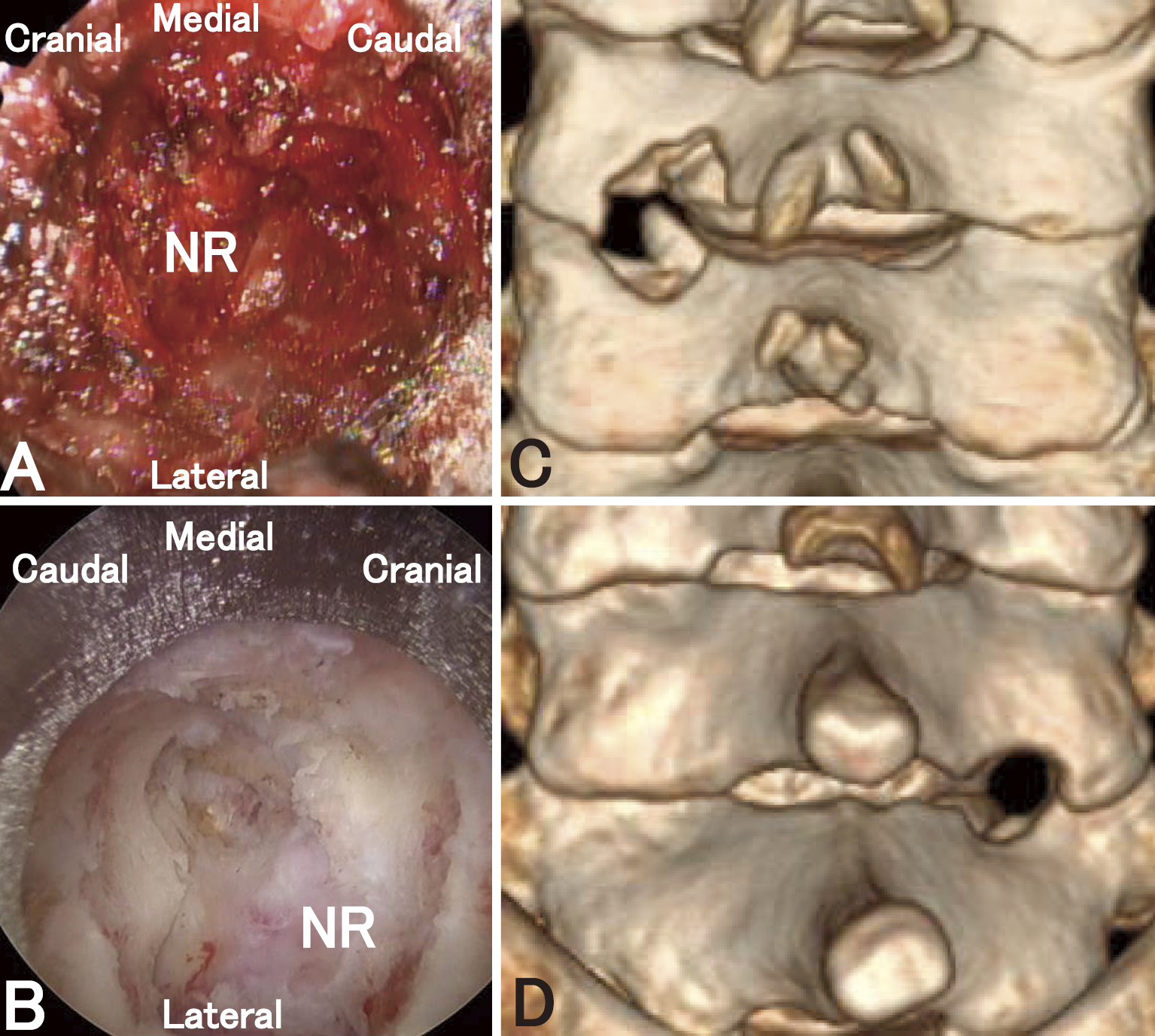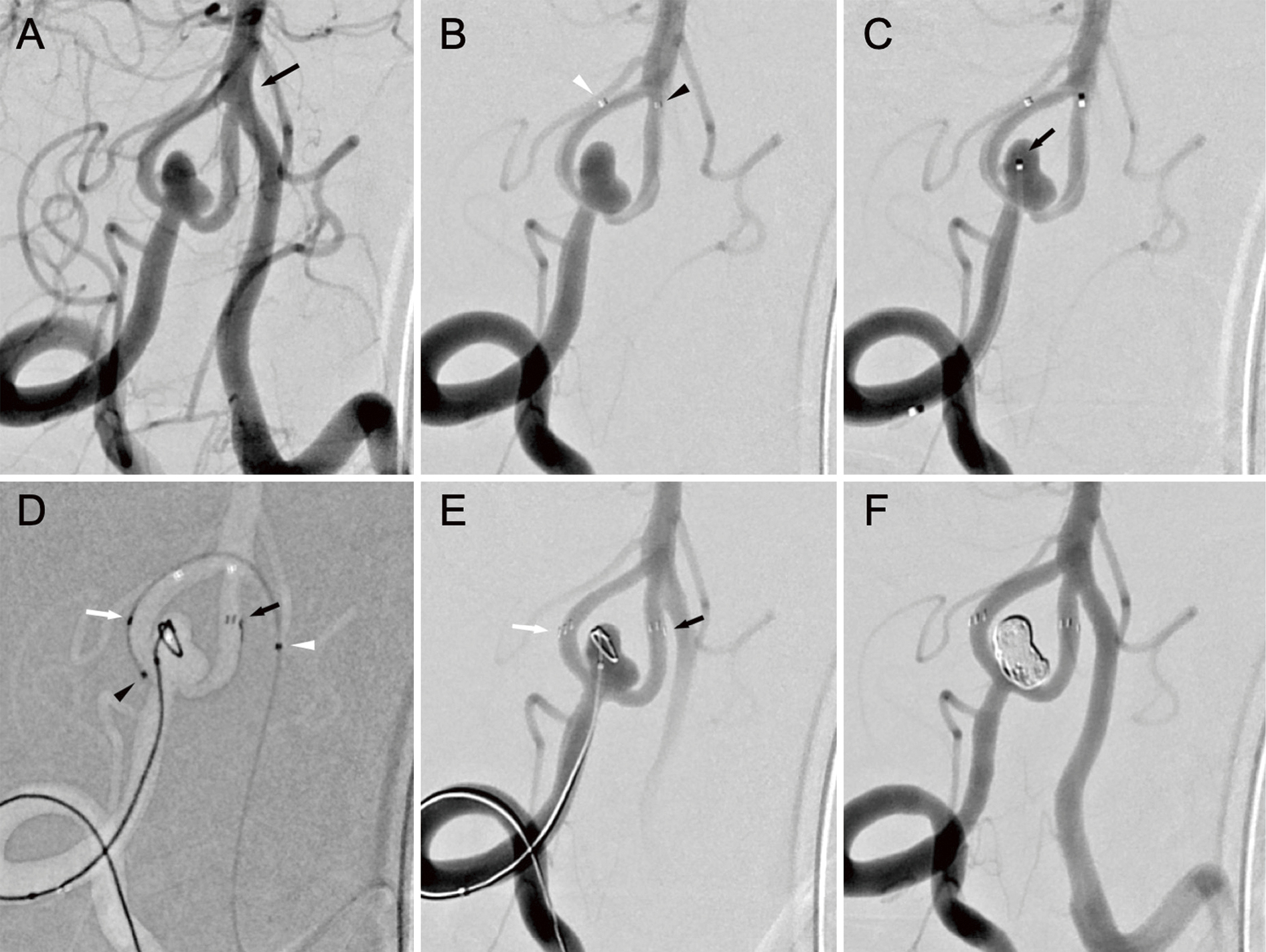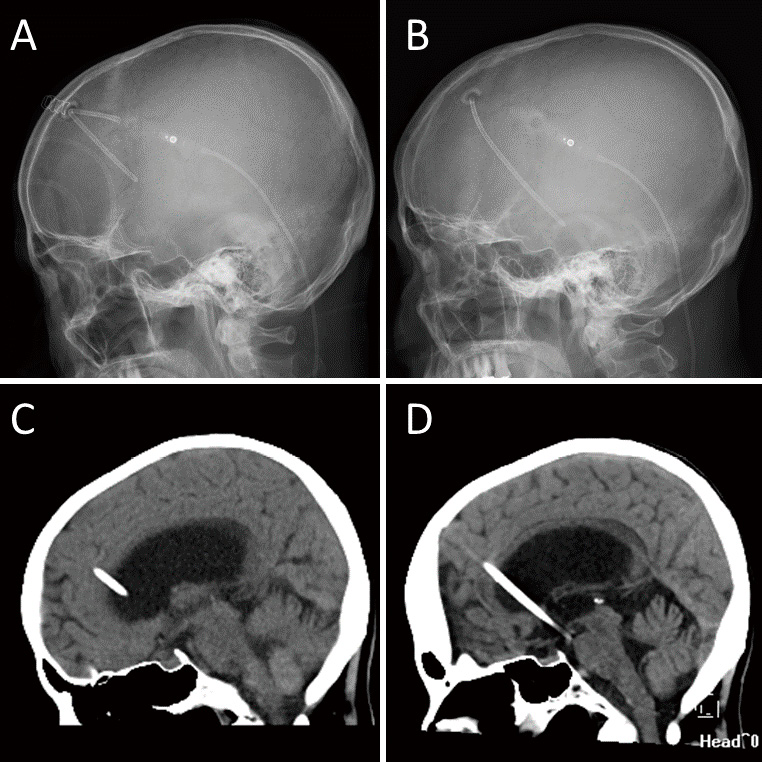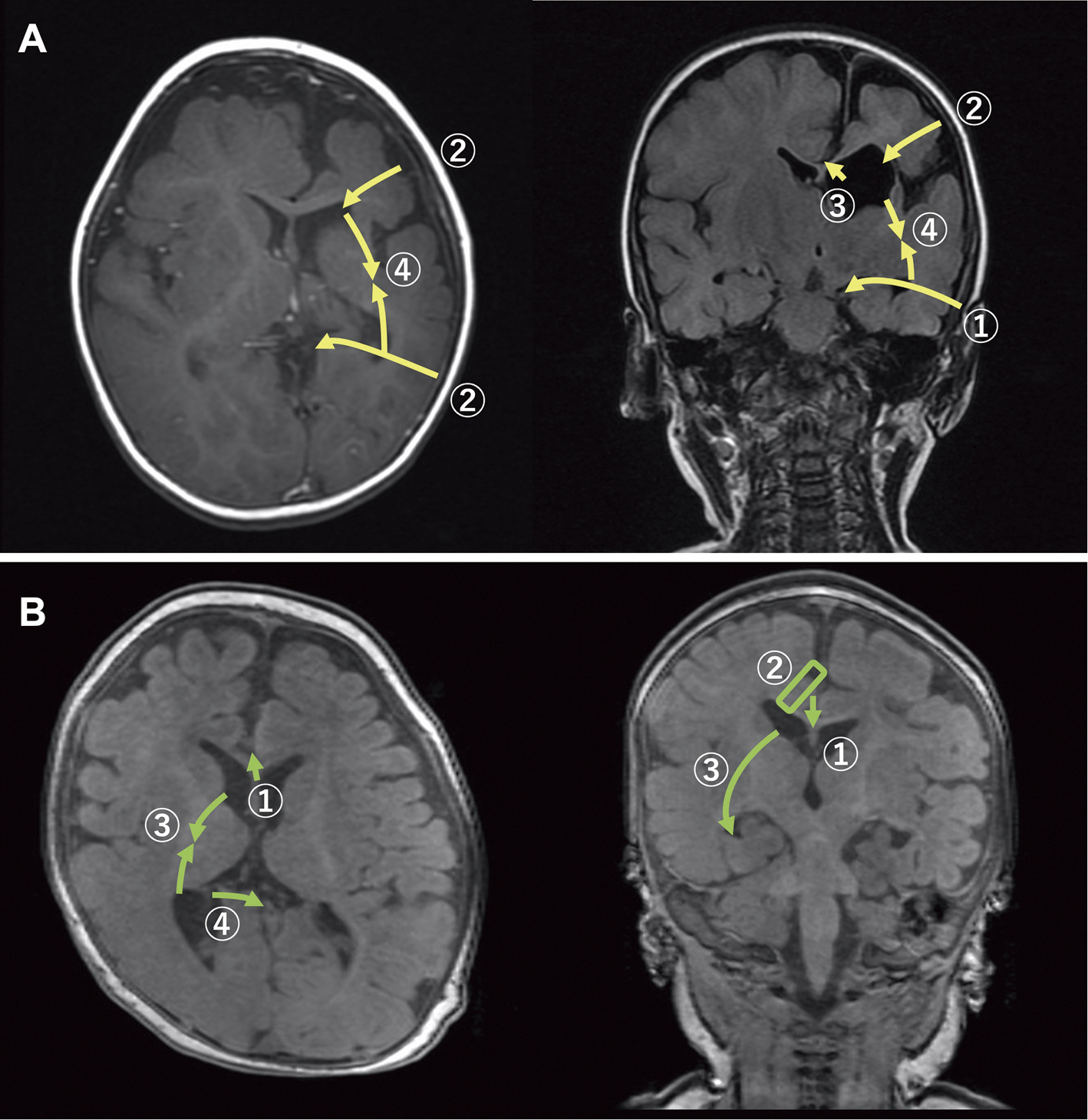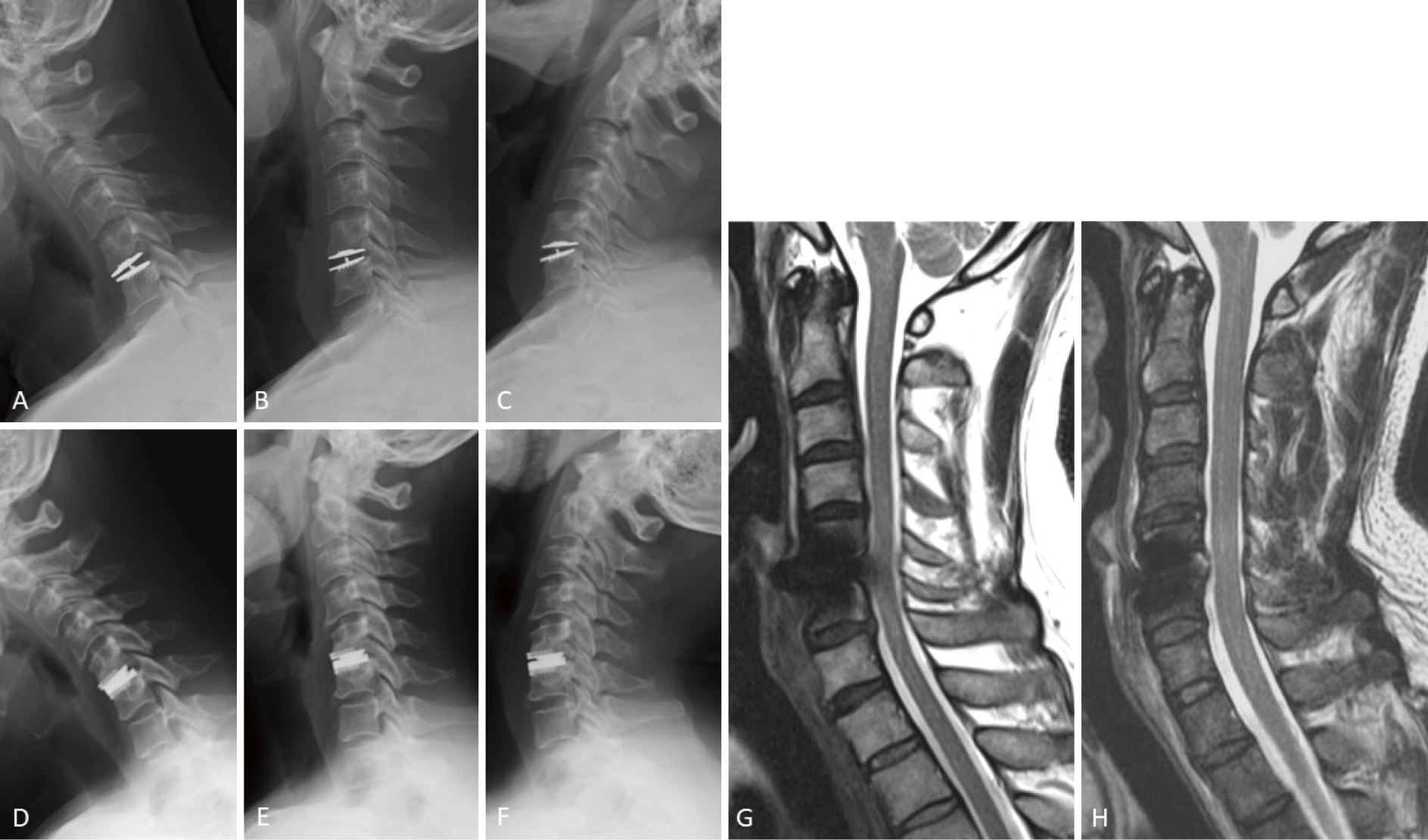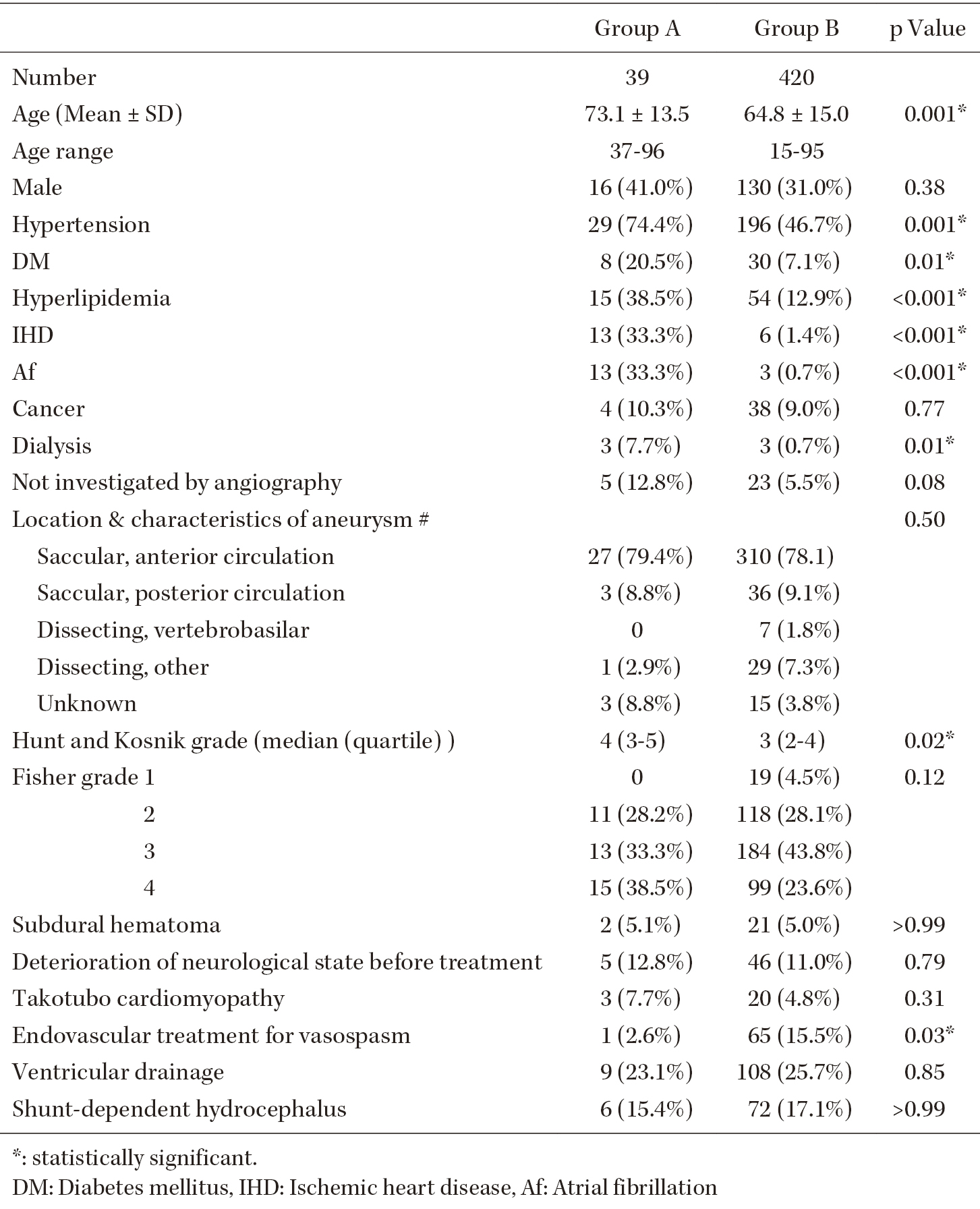- 著者
- Kengo KISHIDA Daisuke MARUYAMA Saki KOTANI Nobukuni MURAKAMI Naoya HASHIMOTO
- 出版者
- The Japan Neurosurgical Society
- 雑誌
- Neurologia medico-chirurgica (ISSN:04708105)
- 巻号頁・発行日
- pp.2023-0043, (Released:2023-11-08)
- 参考文献数
- 41
Studies regarding hematoma stiffness and removal difficulty are scarce. This study explored the association between hematoma stiffness and surgical results of endoscopic hematoma removal for intracerebral hemorrhage. It also aimed to clarify factors associated with hematoma stiffness. We classified intracerebral hematoma as either soft or firm stiffness by retrospectively evaluating operative videos by two neurosurgeons. The interobserver reliability of the classification was assessed by calculating the κ values. We investigated the relationship between hematoma stiffness and surgical results. Favorable hematoma removal (FHR) was defined as a residual hematoma volume of ≤15 mL or removal rate of ≥70%. Furthermore, we compared the background characteristics, imaging findings, and laboratory data between the two groups. Forty patients were included in this study. The mean baseline hematoma volume was 69.9 mL (range, 41.3-97.6 mL). FHR was accomplished in 35 cases (87.5%). Thirty-four patients (85%) were in the soft hematoma group (group S). Six patients (15%) were in the firm hematoma group (group F). Classification of hematoma stiffness demonstrated an excellent degree of interobserver agreement (κ score = 0.91). Patients in group S had a high FHR rate (p = 0.018) and short endoscopic procedure times (p = 0.00034). The island sign was present in group S (p = 0.030). Patients in group F had significantly high fibrinogen levels (p = 0.049) and low serum total calcium (p = 0.032), hemoglobin (p = 0.041), and hematocrit (p = 0.011) levels. Hematoma stiffness during endoscopic surgery for intracerebral hemorrhage correlates with surgical results, including the endoscopic procedure time and accomplishing rate of FHR.
- 著者
- Shota HORIIKE Yasuhiro NAKAJIMA Mamoru MATSUO Akinori KAGEYAMA Ayako MOTOMURA Takashi TSUJIUCHI Ryuta SAITO
- 出版者
- The Japan Neurosurgical Society
- 雑誌
- NMC Case Report Journal (ISSN:21884226)
- 巻号頁・発行日
- vol.10, pp.157-162, 2023-12-31 (Released:2023-06-06)
- 参考文献数
- 19
A 68-year-old man presented with a Jefferson fracture leading to lower cranial nerve palsies affecting the ninth, tenth, and twelfth cranial nerves with a traumatic basilar impression. On the X day, the patient underwent occipitocervical posterior fixation surgery; the surgery was uneventful. However, just after the surgery, epipharyngeal palsy and airway obstruction occurred. Consequently, tracheostomy was needed. On the X+8 day, speech-language pathology (SLP) therapy was initiated for decannulation. On the X+21 day, the patient could clear all the checkpoints and was decannulated. On the X+36 day, the patient was discharged home and SLP therapy was continued. On the X+171 day, his SLP therapy was halted. However, the patient continued to complain that he could not speak as fast as before, and his quality of life remained compromised. Some studies reported that lower cranial nerve palsies affecting the ninth to the twelfth cranial nerve occur in conjunction with Jefferson fractures. Thus, SLP therapy is crucial for Jefferson fracture cases.
- 著者
- Yoshiro ITO Hisayuki HOSOO Masayuki SATO Aiki MARUSHIMA Mikito HAYAKAWA Yuji MATSUMARU Eiichi ISHIKAWA
- 出版者
- The Japan Neurosurgical Society
- 雑誌
- Neurologia medico-chirurgica (ISSN:04708105)
- 巻号頁・発行日
- pp.2022-0361, (Released:2023-09-23)
- 参考文献数
- 25
In the transsylvian (TS) approach, as characterized by clipping surgery, the presurgical visualization of the superficial middle cerebral vein (SMCV) can help change the surgical approach to ensure safe microsurgery. Nevertheless, identifying preoperatively the venous structures that are involved in this approach is difficult. In this study, we investigated the venous structures that are involved in the TS approach using three-dimensional (3D) rotational venography (3D-RV) and evaluated the effectiveness of this method for presurgical simulation. Patients who underwent 3D-RV between August 2018 and June 2020 were involved in this retrospective study. The 3D-RV and partial maximum intensity projection images with a thickness of 5 mm were computationally reconstructed. The venous structures were subdivided into the following three portions according to the anatomic location: superficial, intermediate, and basal portions. In the superficial portion, predominant frontosylvian veins were observed on 31 (41%) sides, predominant temporosylvian veins on seven (9%) sides, and equivalent fronto- and temporosylvian veins on 28 (37%) sides. The veins in the intermediate (deep middle cerebral and uncal veins) and basal portions (frontobasal bridging veins) emptied into the SMCV on 57 (75%) and 34 (45%) sides, respectively. The 3D-RV images were highly representative of the venous structures observed during microsurgery. In this study, 3D-RV was utilized to capture the details of the venous structures from the superficial to the deep portions. Presurgical simulation of the venous structures that are involved in the TS approach using 3D-RV may increase the safety of microsurgical approaches.
- 著者
- Blumstein GIDEON Kento TAKEBAYASHI Takahiro INUI Yasushi OSHIMA Hiroki IWAI Hirohiko INANAMI Hisashi KOGA
- 出版者
- The Japan Neurosurgical Society
- 雑誌
- Neurologia medico-chirurgica (ISSN:04708105)
- 巻号頁・発行日
- pp.2023-0073, (Released:2023-07-10)
- 参考文献数
- 21
- 被引用文献数
- 1
This study aimed to compare the outcomes of microendoscopic cervical foraminotomy (MECF) versus full-endoscopic cervical foraminotomy (FECF) for treating cervical radiculopathy (CR).A retrospective study was performed on patients with CR treated using MECF (n = 35) or FECF (n = 89). A 16-mm tubular retractor and endoscope was used for MECF, while a 4.1-mm working channel endoscope was used for FECF. Patient background and operative data were collected. The numerical rating scale (NRS) and the Neck Disability Index scores were recorded preoperatively and at 1 year postoperatively. Postoperative subjective satisfaction was also assessed.Although the NRS, and NDI scores, as well as postoperative satisfaction at 1 year considerably improved in both groups, one of the background data (number of operated vertebral level) was significantly different. Therefore, we separately analyzed single- and two-level CR. In single-level CR, operation time, intraoperative bleeding, postoperative stay, NDI after 1 year, and reoperation rate were statistically superior in FECF group. In two-level CR, the postoperative stay was statistically superior in FECF group. Three postoperative hematomas were observed in the MECF group, while none was observed in the FECF group.Operative outcomes did not significantly differ between groups. We did not observe postoperative hematoma in FECF even without placement of a postoperative drain. Therefore, we recommend FECF as the first option for the treatment of CR as it has a better safety profile and is minimally invasive.
- 著者
- Eisaku TERADA Takeo NISHIDA Yuya FUJITA Yohei MAEDA Masaki HAYAMA Masatoshi TAKAGAKI Hajime NAKAMURA Satoru OSHINO Youichi SAITOH Haruhiko KISHIMA
- 出版者
- The Japan Neurosurgical Society
- 雑誌
- NMC Case Report Journal (ISSN:21884226)
- 巻号頁・発行日
- vol.10, pp.215-220, 2023-12-31 (Released:2023-07-13)
- 参考文献数
- 20
- 被引用文献数
- 1
We report a case of invasive sphenoid sinus aspergillosis with progressive internal carotid artery (ICA) stenosis and contralateral carotid occlusion that was successfully treated with percutaneous transluminal angioplasty and stenting (PTAS). A 70-year-old man presented with right-sided visual disturbance, ptosis, and left hemiparesis. Magnetic resonance imaging of the head revealed a space-occupying lesion within the sphenoid sinus with infiltration of the bilateral cavernous sinuses, right ICA occlusion, and multiple watershed cerebral infarcts involving the right cerebral hemisphere. The patient was diagnosed with invasive sinus aspergillosis based on transnasal biopsy findings. Despite intensive antifungal therapy using voriconazole, rapidly progressive aspergillosis led to a new stenotic lesion in the left ICA, which increased the risk of bilateral cerebral hypoperfusion. We performed successful PTAS to prevent critical ischemic events. Finally, aspergillosis was controlled with voriconazole treatment, and the patient was discharged. He showed a favorable outcome, with a patent left ICA observed at a 3-year follow-up. PTAS may be feasible in patients with ICA stenosis and invasive sinus aspergillosis.
- 著者
- Ryosuke OTSUJI Toshiyuki AMANO Satoshi MATSUO Yuichiro MIYAMATSU Kenta HARA So TOKUNAGA Akira NAKAMIZO
- 出版者
- The Japan Neurosurgical Society
- 雑誌
- NMC Case Report Journal (ISSN:21884226)
- 巻号頁・発行日
- vol.9, pp.151-155, 2022-12-31 (Released:2022-06-15)
- 参考文献数
- 28
- 被引用文献数
- 1
Endovascular embolization of the middle meningeal artery (MMA) has been reported as an effective method for treating chronic subdural hematoma (CSDH); however, its preventive effect on CSDH following craniotomy is unknown. We present a case in which MMA embolization was ineffective in preventing CSDH following craniotomy. A 56-year-old man who complained of diplopia was diagnosed with sphenoid ridge meningioma with a 3-cm diameter. MMA embolization prior to the operation and total surgical removal of the tumor were performed. Two months postoperatively, the patient complained of headache and hemiparesis of the left side. CSDH with a 15-mm thickness and a midline shift was observed. MMA embolization before inflammation may not play a role in preventing CSDH development because MMA embolization is considered effective in CSDH because it is associated with the blood supply of neovessels that are newly formed due to inflammation. Therefore, MMA embolization might not be effective in preventing the occurrence of CSDH following craniotomy.
- 著者
- Takashi IWAMA Katsuhiro MIZUTANI Hajime KUBO Masahiro KATSUMATA Takenori AKIYAMA Masahiro TODA
- 出版者
- The Japan Neurosurgical Society
- 雑誌
- NMC Case Report Journal (ISSN:21884226)
- 巻号頁・発行日
- vol.10, pp.125-130, 2023-12-31 (Released:2023-05-17)
- 参考文献数
- 11
Patients with neurofibromatosis type 1 not only have characteristic skin findings but are also known to have vascular disorders due to vascular vulnerability. A 44-year-old man with previously undiagnosed neurofibromatosis type 1 was brought to the emergency room due to a sudden subcutaneous hematoma with no history of trauma. Angiography revealed extravasation from the parietal branch of the right superficial temporal artery, which was embolized with n-butyl-2-cyanoacrylate. However, the next day, the patient exhibited an increased subcutaneous hematoma, and new extravascular leakage was detected at the frontal branch of the superficial temporal artery, which was also embolized with n-butyl-2-cyanoacrylate. The patient had physical findings characteristic of neurofibromatosis type 1, such as café-au-lait spots, and was subsequently diagnosed with neurofibromatosis type 1. No obvious neurofibroma or any other subcutaneous lesion associated with neurofibromatosis type 1 was identified in the affected area. Massive idiopathic arterial bleeding in the scalp, although infrequent, can be fatal. Neurofibromatosis type 1 should be considered when a subcutaneous scalp hematoma is observed without a history of trauma, even if the facial skin structure appears normal. Neurofibromatosis type 1 is also known to have multiple sources of hemorrhage. Thus, it is important to repeatedly evaluate vascular structures via cerebral angiography, contrast-enhanced computed tomography, and magnetic resonance imaging, if necessary.
- 著者
- Shizuo HATASHITA Nobunori KOGA Yasuaki HOSAKA Suguru TAKAGI
- 出版者
- The Japan Neurosurgical Society
- 雑誌
- Neurologia medico-chirurgica (ISSN:04708105)
- 巻号頁・発行日
- vol.33, no.1, pp.13-18, 1993 (Released:2006-05-26)
- 参考文献数
- 20
- 被引用文献数
- 68 75
Sixty patients with acute subdural hematoma were treated at Tokyo Metropolitan Hiroo Hospital between 1981 and 1989. The overall mortality was 55% and the functional recovery rate 30%. Thirteen (93%) of 14 patients with a Glasgow Coma Scale (GCS) score of 3 died, while all eight patients with a GCS score of 7 or more achieved functional recovery. The mortality of patients with GCS scores of 4-6 ranged from 45 to 67%. Patients with GCS scores of 4-6 over 65 years old had a mortality of 82%, compared to 50% mortality for those aged 19-40 years. The mortality for patients with GCS scores of 4-6 operated on within 4 hours of injury was 62% in contrast to 33% for those operated on from 4 to 10 hours. Patients with GCS scores of 4-6 who underwent craniotomy with evacuation of the hematoma achieved significantly better recovery than those treated by burr holes. Four patients with GCS scores of 4-6 died in spite of decompressive craniectomy or craniotomy with duroplasty. The mortality is only influenced by age and type of surgical intervention among patients with GCS scores of 4-6. Shorter time from injury to surgical evacuation does not affect mortality within 10 hours of injury.
- 著者
- Satoru OSHINO Naoki TANI Hui Ming KHOO Kuriko KAGITANI-SHIMONO Shin NABATAME Koji TOMINAGA Takufumi YANAGISAWA Masayuki HIRATA Haruhiko KISHIMA
- 出版者
- The Japan Neurosurgical Society
- 雑誌
- Neurologia medico-chirurgica (ISSN:04708105)
- 巻号頁・発行日
- pp.2022-0300, (Released:2023-04-06)
- 参考文献数
- 11
- 被引用文献数
- 2
Successful surgery for drug-resistant pediatric epilepsy can facilitate motor and cognitive development and improve quality of life by resolution or reduction of epileptic seizures. Therefore, surgery should be considered early in the disease course. However, in some cases, the estimated surgical outcomes are not achieved, and additional surgical treatments are considered. In this study, we investigated the clinical factors related with such unsatisfactory outcomes.We reviewed the clinical data of 92 patients who underwent 112 surgical procedures (69 resection and 53 palliation procedures). Surgical outcomes were assessed according to the postoperative disease status, which was classified as good, controlled, and poor. The following clinical factors were analyzed in relation to surgical outcome: sex, age at onset, etiology (malformation of cortical development, tumor, temporal lobe epilepsy, scar, inflammation, and non-lesional epilepsy), presence of genetic cause, and history of developmental epileptic encephalopathy. At a median of 59 (30-81.25) months after the initial surgery, the disease status was good in 38 (41%), controlled in 39 (42%), and poor in 15 (16%) patients. Among the evaluated factors, etiology exhibited the strongest correlation with surgical outcomes. Tumor-induced and temporal lobe epilepsy were correlated with good, whereas malformation of cortical development, early seizure onset, and presence of genetic cause were correlated with poor disease status. Although epilepsy surgery for the patients who present with the latter factors is challenging, these patients demonstrate a greater need for surgical treatment. Hence, development of more effective surgical options is warranted, including palliative procedures.
- 著者
- Haruka MIYATA Futa NINOMIYA Tomoaki FUJITA Yutaka NONOYAMA Takuya NAKAZAWA Shigeharu FUKAO
- 出版者
- The Japan Neurosurgical Society
- 雑誌
- Neurologia medico-chirurgica (ISSN:04708105)
- 巻号頁・発行日
- pp.2022-0309, (Released:2023-03-31)
- 参考文献数
- 23
Horizontal stenting protects the aneurysm neck with stent deployment across the aneurysm neck via the circle of Willis. A saccular aneurysm associated with intracranial arterial fenestration is very rare. Herein, we describe the first case of an unruptured aneurysm related to intracranial arterial fenestration treated with horizontal stenting. A 23-year-old woman presented with a 7-mm broad-necked aneurysm at the fenestration of the right intracranial vertebral artery (VA), which was incidentally found on magnetic resonance imaging. The patient underwent endovascular treatment with horizontal stenting via the vertebrobasilar junction from the contralateral left VA, followed by coil embolization using a jailed microcatheter from the ipsilateral right VA. The procedure was finished with sufficient embolization, and no complications occurred. Horizontal stent delivery via the vertebrobasilar junction for coil embolization of a broad-necked aneurysm arising from the fenestration of the VA is a safe and effective therapeutic strategy.
2 0 0 0 OA A Consideration of Optimal Head Position in Transsylvian Selective Amygdalohippocampectomy
- 著者
- Tadashi HAMASAKI Hiroki UCHIKAWA Tatsuya KAWANO Keitaro KAI Tastuya TAKEZAKI Akitake MUKASA
- 出版者
- The Japan Neurosurgical Society
- 雑誌
- Neurologia medico-chirurgica (ISSN:04708105)
- 巻号頁・発行日
- pp.2022-0283, (Released:2023-04-13)
- 参考文献数
- 19
Transsylvian selective amygdalohippocampectomy (TSA) is one of the predominant surgical options for drug-resistant mesial temporal lobe epilepsy. The purpose of this article is to highlight the unique features of TSA and determine the setting to perform safe and secure TSA with special reference to the optimal head position. TSA should be performed via a small surgical corridor in the temporal stem that contains functionally important fiber tracts, including the uncinate fasciculus, the inferior fronto-occipital fasciculus, and the optic radiation. Graphical simulations proposed that low-degree (<30°) head rotation had the advantage of sufficiently opening the surgical field in TSA and may help surgical procedures within the limited exposure of the medial temporal structures. Inspection of the surgical videos implied that the collapse of the inferior horn was prevented in low-degree rotation, probably because the deformation due to the brain shift was minimized in the medial temporal structures. A simulation also implied that chin-up position had the advantage of resecting the tail of the hippocampus in a straightforward manner. We suggest that the setting is optimized in TSA with low-degree rotation and chin-up head position.
- 著者
- Isamu MIURA Shiro HORISAWA Takakazu KAWAMATA Takaomi TAIRA
- 出版者
- The Japan Neurosurgical Society
- 雑誌
- NMC Case Report Journal (ISSN:21884226)
- 巻号頁・発行日
- vol.10, pp.99-102, 2023-12-31 (Released:2023-04-10)
- 参考文献数
- 16
Cervical dystonia, characterized by the involuntary contraction of cervical muscles, is the most common form of adult dystonia. In a patient with intractable cervical dystonia, we carried out a myotomy of the left obliquus capitis inferior and selective peripheral denervation (SPD) of the posterior branches of the C3-C6 spinal nerves based on preoperative 18F-fluorodeoxyglucose (18F-FDG) positron emission tomography/computed tomography (PET/CT). The patient was a 65-year-old, right-handed man with an unremarkable medical history. His head rotated involuntarily to the left. Medication and botulinum toxin injections were ineffective, and surgical treatment was considered. 18F-FDG PET/CT imaging revealed FDG uptake in the left obliquus capitis inferior, right sternocleidomastoideus, and left splenius capitis. Myotomy of the left obliquus capitis inferior and SPD of the posterior branches of the C3-C6 spinal nerves was performed under general anesthesia. During the 6-month follow-up, the patient's Toronto Western Spasmodic Torticollis Rating Scale score improved from 35 to 9. This case shows that preoperative 18F-FDG PET/CT is effective in identifying dystonic muscles and determining the surgical strategy for cervical dystonia.
- 著者
- Shigeta MIYAKE Yasunobu NAKAI Taisuke AKIMOTO Shun ISHIKAWA Wakiko SARUTA Hiroki KURODA Satoru SHIMIZU Tetsuya YAMAMOTO
- 出版者
- The Japan Neurosurgical Society
- 雑誌
- Neurologia medico-chirurgica (ISSN:04708105)
- 巻号頁・発行日
- pp.2022-0397, (Released:2023-04-06)
- 参考文献数
- 8
Common carotid artery (CCA) occlusion (CCAO) is a rare cause of ischemic stroke and bypass surgery is the common treatment approach. However, safer alternatives should be developed to treat CCAO. A 68-year-old male was diagnosed with left-sided CCAO with decreased left visual acuity due to neck radiation therapy for laryngeal cancer. Recanalization therapy using a pull-through technique was initiated because cerebral blood flow progressively decreased during the follow-up period. First, after a short sheath was inserted into the CCA, the occluded CCA was retrogradely penetrated through the sheath. Second, a micro-guidewire was guided to the aorta from the femoral sheath where it was caught using a snare wire guided from the cervical sheath. Subsequently, the micro-guidewire was gently pulled out from the cervical sheath, penetrated the occluded lesion, and was secured to the femoral and cervical sheaths. Finally, the occluded lesion was dilated using a balloon, and the stent was placed. Five days postprocedure, the patient was discharged uneventfully and exhibited improved left visual acuity. In terms of reliable penetration of obstructive lesions and reduction of embolic and hemorrhagic complications, combined endovascular antegrade and direct retrograde carotid artery stenting is a versatile and minimally invasive treatment option for CCAO.
- 著者
- Kazuo KAKINUMA Keisuke MORIHARA Yoshiteru SHIMODA Nobuko KAWAKAMI Shigenori KANNO Mayuko OTOMO Teiji TOMINAGA Kyoko SUZUKI
- 出版者
- The Japan Neurosurgical Society
- 雑誌
- NMC Case Report Journal (ISSN:21884226)
- 巻号頁・発行日
- vol.10, pp.9-14, 2023-12-31 (Released:2023-02-09)
- 参考文献数
- 43
Idiopathic normal-pressure hydrocephalus (iNPH) is a neurological disorder that typically presents with gait disturbance, cognitive impairment, and urinary incontinence. Although most patients respond to cerebrospinal-fluid shunting, some do not react well because of shunt failure. A 77-year-old female with iNPH underwent ventriculoperitoneal shunt implantation, and her gait impairment, cognitive dysfunction, and urge urinary incontinence improved. However, 3 years after shunting (at the age of 80), her symptoms gradually recurred for 3 months and she did not respond to shunt valve adjustment. Imaging studies revealed that the ventricular catheter detached from the shunt valve and migrated into the cranium. With immediate revision of the ventriculoperitoneal shunt, her gait disturbance, cognitive dysfunction, and urinary incontinence improved. When a patient whose symptoms have been relieved by cerebrospinal-fluid shunting experiences an exacerbation, it is important to suspect shunt failure, even if many years have passed since the surgery. Identifying the position of the catheter is crucial to determine the cause of shunt failure. Prompt shunt surgery for iNPH can be beneficial, even in elderly patients.
- 著者
- Hiroaki SHIMIZU Takahiro ONO Takatsugu ABE Masaaki HOKARI Yusuke EGASHIRA Koji SHIMONAGA Masahiko KAWANISHI Kyoko NOMURA Yusuke TAKAHASHI
- 出版者
- The Japan Neurosurgical Society
- 雑誌
- Neurologia medico-chirurgica (ISSN:04708105)
- 巻号頁・発行日
- pp.2022-0249, (Released:2023-01-05)
- 参考文献数
- 21
Intracranial carotid artery dissection causing cerebral ischemia is a rare but important cause of cerebral infarction in children and adolescents. Although endovascular therapy has been reported to be effective, questions regarding the indications for intervention are yet to be addressed. Therefore, this study aimed to evaluate factors related to clinical outcomes through a nationwide survey. Overall, 35 neurosurgical centers reported patients within 2 weeks after ischemic onset due to intracranial carotid artery dissection causing cerebral ischemia treated between January 2015 and December 2020. Data on clinical and radiological findings were statistically analyzed. Twenty-eight patients met the inclusion criteria. The median age was 36 years (range, 7-59 years), without sex differences. Headache at onset was documented in 60.7% of the patients. Dissection findings were categorized into stenosis (71.4%) or occlusion (28.6%). Initial treatments, including various antithrombotic agent combinations in 23 (82.1%) patients, effectively improved or prevented aggravation in half of the patients. The patients with stenotic dissection were significantly more likely to experience aggravation during the initial treatment than did those with occlusive dissection (P = 0.03). In addition, the patients with moderate to severe neurological deficits on admission had poorer outcomes at discharge more frequently than did those with mild neurological deficits on admission. Eight patients undergoing endovascular therapy had no procedural complications or further aggravation after intervention. In conclusion, patients with intracranial carotid dissection causing cerebral ischemia who had a stenotic dissection were at risk of further aggravation, and endovascular therapy effectively improved or prevented aggravation.
2 0 0 0 OA Surgical Strategy for Hemispherotomy
- 著者
- Takeshi MATSUO So FUJIMOTO
- 出版者
- The Japan Neurosurgical Society
- 雑誌
- Neurologia medico-chirurgica (ISSN:04708105)
- 巻号頁・発行日
- pp.2022-0279, (Released:2023-01-20)
- 参考文献数
- 21
Hemispherotomy is a radical treatment for drug-resistant epilepsy that targets developmental, acquired, and progressive diseases with widespread epileptogenic regions in one cerebral hemisphere. Currently, two main approaches are utilized after repeated improvements: lateral and vertical approaches. With the lateral approach, the surgical field is wide, and the approach to the lateral ventricle is relatively easy. On the other hand, the vertical approach has the advantage of reducing intraoperative bleeding and operating time as the resection line of the radial fiber is short, and understanding the three-dimensional anatomy is relatively easy. The lateral approach is generally used for atrophic lesions, whereas the vertical approach is for hypertrophic lesions. Hemispherotomy is expected to not only suppress epileptic seizures but also improve psychomotor development by protecting the unaffected cerebral hemisphere. However, this method is one of the most invasive surgeries in epilepsy surgery, and it is important to fully consider its indications. Furthermore, understanding the neural fiber pathway is important for actual surgery.
- 著者
- Hiroshi MIYABAYASHI Nobuhiko NAGANO Shin HASHIMOTO Katsuya SAITO Risa KATO Takanori NOTO Mari SASANO Koichiro SUMI Atsuo YOSHINO Ichiro MORIOKA
- 出版者
- The Japan Neurosurgical Society
- 雑誌
- Neurologia medico-chirurgica (ISSN:04708105)
- 巻号頁・発行日
- pp.2022-0105, (Released:2022-09-30)
- 参考文献数
- 29
- 被引用文献数
- 5
In this study, we aimed to evaluate the longitudinal changes in the cranial shape of healthy Japanese infants using a three-dimensional scanner and construct a normal values database for the growth process. Preterm infants (gestational age < 37 weeks), infants with neonatal asphyxia (5-minute Apgar score of <7), and patients who started helmet therapy for deformational plagiocephaly were excluded from this study. The first scan was performed at approximately 1 month of age, followed by two scans conducted at 3 and 6 months of age. The parameters considered were as follows: cranial length, width, height, circumference, volume, cranial vault asymmetry index, and cephalic index. A cranial vault asymmetry index >5% was defined as deformational plagiocephaly. Changes in each parameter were examined using repeated-measures analysis of variance classified by sex and deformational plagiocephaly status. The rate of increase in each parameter was also examined. In total, 88 infants (45 boys and 43 girls) were included in this study. All growth-related parameters were noted to increase linearly with time. Sex differences were observed in all parameters except cranial length. Deformational plagiocephaly was found to have no effect on growth-related parameters. Cranial volume increased by 60% from 1 to 6 months of age. The growth almost uniformly influenced the rate of increase in volume in each coordinate axis direction. Overall, the mean trends in three-dimensional parameters in infants up to 6 months of age were obtained using a three-dimensional scanner. These trends could be used as a guide by medical professionals involved in cranioplasty.
- 著者
- Eiichi SUEHIRO Tatsuya TANAKA Masatou KAWASHIMA Akira MATSUNO
- 出版者
- The Japan Neurosurgical Society
- 雑誌
- Neurologia medico-chirurgica (ISSN:04708105)
- 巻号頁・発行日
- pp.2022-0276, (Released:2022-11-25)
- 参考文献数
- 21
The Japan Neurotrauma Data Bank is a source of epidemiological data for patients with severe traumatic brain injury (TBI) and is sponsored by the Japan Society of Neurotraumatology. In this report, we examined the changes in the treatment of severe TBI in Japan based on data of the Japan Neurotrauma Data Bank. Controlling and decreasing intracranial pressure (ICP) are the primary objective of severe TBI treatment. Brain-oriented whole-body control or neurocritical care, including control of cerebral perfusion pressure, respiration, and infusion, are also increasingly considered important because cerebral tissues require oxygenation to improve the outcomes of patients with severe TBI. The introduction of neurocritical care in Japan was delayed compared with that in Western countries. However, the rate of ICP monitoring increased from 28.0% in 2009 to 36.7% in 2015 and is currently likely to be higher. Neurocritical care has also become more common, but the functional prognosis of patients has not significantly improved in Japan. Changes in the background of patients with severe TBI suggest the need for improvement of acute-phase treatment for elderly patients. Appropriate social rehabilitation from the subacute to chronic phases and introduction of cellular therapeutics are also needed for patients with TBI.
- 著者
- Toshihiro TAKAMI Takeshi HARA Masahito HARA Toshihiko INUI Kiyoshi ITO Izumi KOYANAGI Junichi MIZUNO Masaki MIZUNO Hiroyuki NAKASE Nobuyuki SHIMOKAWA Taku SUGAWARA Shinsuke SUZUKI Toshiyuki TAKAHASHI Masakazu TAKAYASU Satoshi TANI Kazutoshi HIDA Phyo KIM Hajime ARAI Neurospinal Society of Japan The Japan Neurosurgical Society
- 出版者
- The Japan Neurosurgical Society
- 雑誌
- Neurologia medico-chirurgica (ISSN:04708105)
- 巻号頁・発行日
- pp.2022-0148, (Released:2022-10-13)
- 参考文献数
- 74
- 被引用文献数
- 2
Anterior cervical disc replacement (ACDR) using cervical artificial disc (CAD) has the advantage of maintaining the range of motion (ROM) at the surgical level, subsequently reducing the postoperative risk of adjacent disc disease. Following the approval for the clinical use in Japan, a post-marketing surveillance (PMS) study was conducted for two different types of CAD, namely, Mobi-C (metal-on-plastic design) and Prestige LP (metal-on-metal design). The objective of this prospective observational multicenter study was to analyze the first 2-year surgical results of the PMS study of 1-level ACDR in Japan. A total of 54 patients were registered (Mobi-C, n = 24, MC group; Prestige LP, n = 30, PLP group). Preoperative neurological assessment revealed radiculopathy in 31 patients (57.4%) and myelopathy in 15 patients (27.8%). Preoperative radiological assessment classified the disease category as disc herniation in 15 patients (27.8%), osteophyte in 6 patients (11.1%), and both in 33 patients (61.1%). The postoperative follow-up rates at 6 weeks, 6 months, 1 year, and 2 years after ACDR were 92.6%, 87.0%, 83.3%, and 79.6%, respectively. In both groups, patients' neurological condition improved significantly after surgery. Radiographic assessment revealed loss of mobility at the surgical level in 9.5% of patients in the MC group and in 9.1% of patients in the PLP group. No secondary surgeries at the initial surgical level and no serious adverse events were observed in either group. The present results suggest that 1-level ACDR is safe, although medium- to long-term follow-up is mandatory to further verify the validity of ACDR for Japanese patients.
- 著者
- Masaaki UNO Kenji YAGI Hiroyuki TAKAI Satoshi HIRAI Yukari MINAMI-OGAWA Yoshifumi TAO Yoshihiro SUNADA Shunji MATSUBARA
- 出版者
- The Japan Neurosurgical Society
- 雑誌
- Neurologia medico-chirurgica (ISSN:04708105)
- 巻号頁・発行日
- pp.2022-0122, (Released:2022-10-13)
- 参考文献数
- 19
With the aging of the population, the number of people taking antithrombotic drugs is increasing. Few reports have described the clinical presentation, treatment, and outcomes of nontraumatic subarachnoid hemorrhage (SAH) in patients with preceding antithrombotic therapy. This study included 459 patients with nontraumatic SAH who had been treated between April 2009 and May 2021. Overall, 39 of the 459 patients with aneurysmal SAH were on antithrombotic therapy before ictus (8.5%). Therefore, we classified patients into two groups: Group A (n = 39), patients with preceding antithrombotic therapy and Group B (n = 420), patients without preceding antithrombotic therapy. Hunt and Kosnik (H&K) grade on admission was significantly higher in Group A than in Group B (p = 0.02). Patients in Group A more frequently received endovascular treatment. The rate of endovascular therapy for symptomatic vasospasm after SAH was significantly lower in Group A (2.6%) than in Group B (15.5%; p = 0.03). The outcomes at 3 months after onset were significantly poorer in Group A patients than in Group B patients (p = 0.03). Patients with preceding antithrombotic drugs tended to be at greater risk of unfavorable outcomes, but this difference was not significant in the univariate analysis. In the multivariate analysis, patient age, H&K grade ≥4, and subdural hematoma remained as risk factors for poor outcomes; however, preceding use of antithrombotic drugs was not a significant risk factor.
